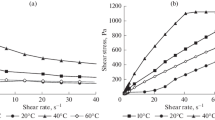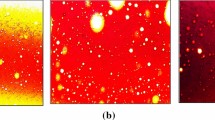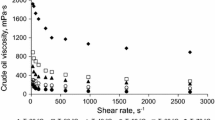Abstract
Water-in-oil type emulsions can be formed during the crude oil production process. The presence of natural surfactants in oil (asphaltenes, resins) and mechanical stirring (piping/well system) produce emulsions, the stability and rheological behaviour of which depend mainly on the chemical composition of the oil and the internal phase concentration. In this work, water (brine 8 g NaCl/cm3) in oil (crude oil) emulsions were prepared and characterised by varying the internal phase concentration (5–80%). Rheological properties are discussed according to the composition of the oil and the temperature of the system. Relative viscosity was modelled following the classical models of Mooney and Krieger and Dougherty, but the best-fitting model for the experimental results was found with an exponential type equation between relative viscosity and volume fraction, as proposed by Richardson. Moreover, we observed that the plastic behaviour determined through the yield stress determination depended not only on the internal phase concentration but also on the temperature. Quantitative analysis of the emulsions’ viscoelastic parameters (storage and loss modulus) was made. In the case of concentrated emulsions (containing over 70% of internal phase), Princen’s theory of the high internal phase ratio emulsions (HIPRES) was verified.







Similar content being viewed by others
References
Alvarez-Solano OA (2006) Emulsions inverses très concentrées. Influence du procédé et de la formulation sur leurs propriétés rhéologliques. Doctoral thesis, Institut National Polytechnique de Lorraine, Nancy, France
Baravian C, Mougel J, Alvarez O (2006) Physical properties of non stable gel emulsions with non ionic surfactant. Proceedings of the 4th Congress on Emulsion, Lyon, France, Abstract 281
Broughton G, Squires L (1938) The viscosity of oil–water emulsions. J Phys Chem 42:253–263
Camy JM, Mardsen SS, Hung B, JE, Arihara N, Casse FS, Alvarado QDA, Mandel L, Mobarak S, Gonzalez GHO, Mao ML, Samaniego VF, Romero GE, Rivera RJ, Marius CG (1975) The rheology of crude oil dispersions. Proceedings of the International Symposium of Oilfield Chemistry of the Society of Petroleum Engineers, Dallas, USA, paper 5299, pp 51–68
Clausse D, Gomez F, Dalmazzone C, Noïk C (2005) A method for the characterization of emulsions, thermogranulometry: application to water-in-crude oil emulsion. J Colloid Interface Sci 287:694–703
Einstein A (1906) Eine neue Bestimmung der Moleküldimensionen. Ann Phys 19:289–306
Farah MA, Oliveira RC, Caldas JN, Rajagopal K (2005) Viscosity of water-in-oil emulsions: variation with temperature and water volume fraction. J Pet Sci Eng 48:169–184
Jager-Lezer N, Tranchant JF, Alard V, Vu C, Tchoreloff PC, Grossiord JL (1998) Rheological analysis of highly concentrated w/o emulsions. Rheol Acta 37:129–138
Krieger IM, Dougherty TJ (1959) A mechanism for non-Newtonian flow in suspensions of rigid spheres. Trans Soc Rheol 3:137–152
Langenfeld A, Stébé MJ (2002) Influence of the physic-chemical parameters on rheological properties of concentrated reverse emulsions. Phys Chem Chem Phys 4:322–327
Langevin D, Poteau S, Hénaut I, Argillier JF (2004) Crude oil emulsion properties and their application to heavy oil transportation. Oil Gas Sci Technol 59:511–521
Mao M, Marsden SS (1977) Stability of concentrated crude-oil-in-water emulsions as a function of shear rate, temperature, and oil concentration. J Can Pet Tech 16:54–59
Mason TG (1999) New fundamental concepts in emulsion rheology. Curr Opin Colloid Interface Sci 4:231–238
Mooney M (1951) The viscosity of a concentrated suspension of spherical particles. Journal of Colloid Science 6:162–170
Nädler M, Mews D (1992) Characteristics of gas–liquid and gas–liquid–liquid slug flow in horizontal pipes. Proceedings of the ASME FED International Symposium on Multiphase Flow in Wells and Pipelines, Anaheim, USA, vol 144, pp 39–50
Pal R (1996) Viscoelastic properties of polymer-thickened oil-in-water emulsions. Chem Eng Sci 51:3299–3305
Pal R (1999) Yield stress and viscoelastic properties of high internal phase ratio emulsions. Colloid Polym Sci 277:583–588
Pal R (2000) Linear viscoelastic behavior of multiphase dispersions. J Colloid Interface Sci 232:50–63
Pal R (2006) Rheology of high internal phase ratio emulsions. Food Hydrocolloid 20:997–1005
Ponton A, Clement P, Grossiord JL (2001) Corroboration of Princen’s theory to cosmetic concentrated water-in-oil emulsions. J Rheol 45:521–526
Princen HM, Kiss AD (1986) Rheology of foams and highly concentrated emulsions. 3. Static shear modulus. J Colloid Interface Sci 112:427–437
Princen HM, Kiss AD (1989) Rheology of foams and highly concentrated emulsions IV. An experimental study of the shear viscosity and yield stress of concentrated emulsions. J Colloid Interface Sci 128:176–187
Richardson EG (1933) Über die viskosität emulsionen. Kolloid-Z 65:32–37
Rønningsen HP (1995) Correlations for predicting viscosity of W/O-emulsions based on North Sea crude oils. Proceedings of the International Symposium on Oilfield Chemistry, San Antonio, USA, paper 28968
Rønningsen HP, Bjømdal B (1991) Wax precipitation from north sea crude oils. 1. Crystallization and dissolution temperatures, and Newtonian and non-Newtonian flow properties. Energy Fuels 5:895–908
Rose SC, Marsden, SS (1970) The flow of north slope crude oil and its emulsions at low temperatures. Proceedings of the 45th Annual Fall Meeting of the Society of Petroleum Engineers, Houston, USA, paper 2996
Salager JL, Briceno MI, Bracho CL (2001) Heavy hydrocarbon emulsions. Making use of the state of the art in formulation engineering. In: Sjöblom J (ed) Encyclopedic handbook of emulsion technology. Marcel Dekker, New York, pp 455–495
Simon RP, Poynter WG (1968) Down-hole emulsification for improving viscous crude production. J Pet Technol 20:1349–1353
Taylor P (1996) The effect of an anionic surfactant on the rheology and stability of high volume fraction O/W emulsion stabilized by PVA. Colloid Polym Sci 274:1061–1071
Tscheuschner HD (1994) Rheological and processing properties of fluid chocolate. Appl Rheol 4:83–88
Acknowledgments
The authors want to acknowledge the worthy support of Mrs. Stella Ghouti of the Modern Language Department, Paris Sud-11 University who reviewed and corrected the whole manuscript.
Author information
Authors and Affiliations
Corresponding author
Rights and permissions
About this article
Cite this article
Quintero, C.G., Noïk, C., Dalmazzone, C. et al. Modelling and characterisation of diluted and concentrated water-in-crude oil emulsions: comparison with classical behaviour. Rheol Acta 47, 417–424 (2008). https://doi.org/10.1007/s00397-008-0262-7
Received:
Revised:
Accepted:
Published:
Issue Date:
DOI: https://doi.org/10.1007/s00397-008-0262-7




